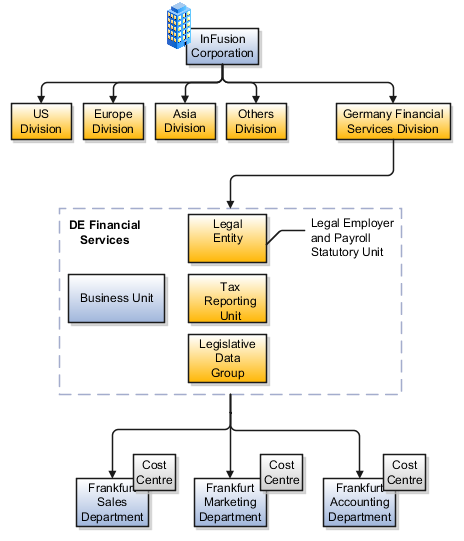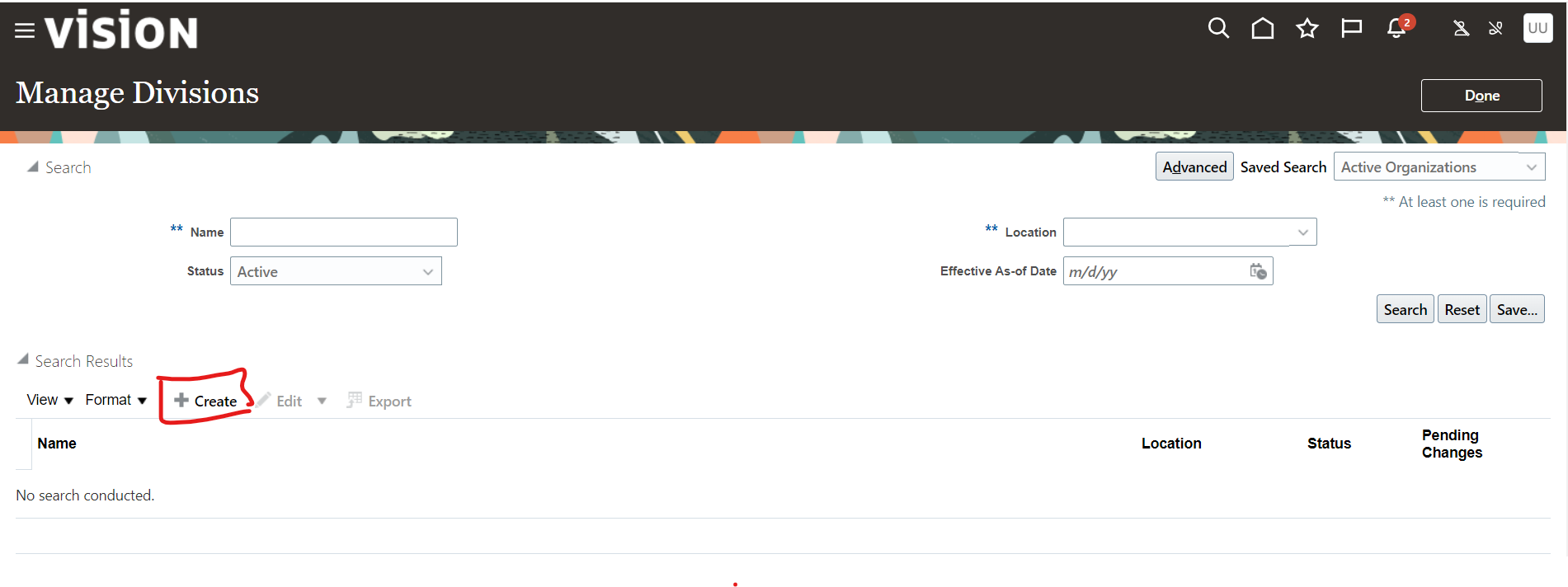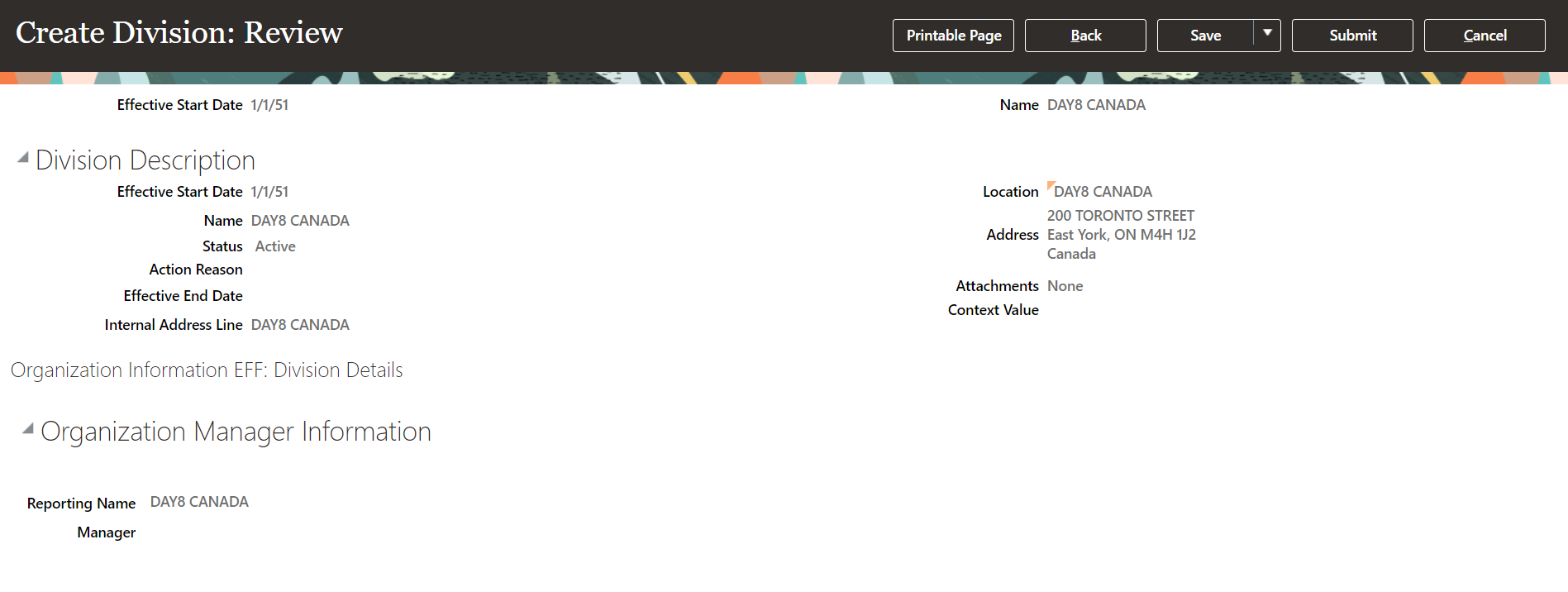Divisions
Managing multiple businesses requires that you segregate them by their strategic objectives and measure their results.
Responsibility to reach objectives can be delegated along the management structure. Although related to your legal structure, the business organizational hierarchies don’t reflect directly the legal structure of the enterprise. The management entities and structure can include:
- Divisions and subdivisions
- Lines of business
- Other strategic business units
- Their own revenue and cost centers
These organizations can be included in many alternative hierarchies and used for reporting, as long as they have representation in the chart of accounts.
Divisions
A division refers to a business-oriented subdivision within an enterprise, in which each division organizes itself differently to deliver products and services or address different markets. A division can operate in one or more countries, and can be many companies or parts of different companies that are represented by business units.
A division is a profit center or grouping of profit and cost centers, where the division manager is responsible for achieving business goals including profits. A division can be responsible for a share of the company’s existing product lines or for a separate business. Managers of divisions may also have return on investment goals requiring tracking of the assets and liabilities of the division. The division manager generally reports to a corporate executive.
By definition a division can be represented in the chart of accounts. Companies can use product lines, brands, or geographies as their divisions: their choice represents the primary organizing principle of the enterprise.
Historically, divisions were implemented as a node in a hierarchy of segment values. For example, Oracle E-Business Suite has only one balancing segment, and often the division and legal entity are combined into a single segment where each value stands for both division and legal entity.
Use of Divisions in Oracle Fusion Cloud Human Capital Management (HCM)
Divisions are used in HCM to define the management organization hierarchy, using the generic organization hierarchy. This hierarchy can be used to create organization-based security profiles.
Example of Adding a New Division After Acquiring a Company
This example describes how you can restructure your enterprise after acquiring a new division.
Scenario
You are part of a senior management team at InFusion Corporation. InFusion is a global company with organizations in the following countries:
- United States (US)
- United Kingdom (UK)
- France
- China
- Saudi Arabia
- United Arab Emirates (UAE)
The company’s main area of business is in the high tech industry, and it recently acquired a new company. You must analyze the company’s current enterprise structure and determine the new organizations to create in the new company.
Details of the Acquired Company
The acquired company is a Financial Services business based in Germany. The Financial Services business differs significantly from the high tech business. Therefore, you want to keep the Financial Services company as a separate business with all the costs and reporting managed by the Financial Services division.
The following table summarizes the key decisions that you must consider when determining what new organizations to set up and how to structure the enterprise.
| Decision to Consider | In This Example |
|---|---|
| Create location? | The Financial Services company and its departments are based in Frankfurt. Therefore, you only have to create one location. |
| Create separate division? | Yes. Although the new division will exist in the current enterprise structure, you want to keep the Financial Services company as a separate line of business. By creating a separate division, you can manage the costs and reporting separately from the InFusion Corporation. Additionally, you don’t have to modify any organizations in the enterprise setup. |
| Create business unit? | Yes. The Financial Services business requires you to create several jobs that don’t exist in your high tech business. You can segregate the jobs that are specific to financial services in a new business unit. |
| How many departments? | The Financial Services company currently has departments for sales, accounting, and marketing. As you have no plans to downsize or change the company, you can create three departments to retain the structure. |
| How many cost centers? | Although you can have multiple cost centers to track the department costs, you decide to create one cost center for each department. |
| How many legal entities? | Define a legal entity for each registered company or some other entity recognized by law. Using the legal entity, you can:
In this case, you only need one legal entity. You must define the legal entity as a legal employer and payroll statutory unit. As the new division operates only from Germany, you can configure the legal entity to suit Germany’s legal and statutory requirements. Note: You can identify the legal entity as a payroll statutory unit. When you do so, the application transfers the legal reporting unit associated with the legal entity to Oracle Fusion HCM as a tax reporting unit. |
| Create legislative data group? | Yes. Because you currently don’t employ or pay people in Germany, you must create one legislative data group to run payroll for the workers in Germany. |
Resulting In Fusion Enterprise Structure
Based on the analysis, you must create the following:
- One new division
- One new location
- Three new departments
- Three new cost centers
- One new legal entity
- One new legislative data group
The following figure illustrates the structure of InFusion Corporation after adding the new division and the other organizations. 


Select + Create


Select Next

